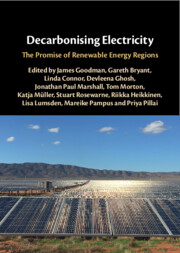
-
Select format
-
- Publisher:
- Cambridge University Press
- Publication date:
- 20 June 2025
- 03 July 2025
- ISBN:
- 9781009485609
- 9781009485616
- Dimensions:
- (244 x 170 mm)
- Weight & Pages:
- 0.63kg, 268 Pages
- Dimensions:
- Weight & Pages:
You may already have access via personal or institutional login
Book description
The current shift to renewable energy is dominated by globalised energy companies building large-scale wind and solar plants. This book discusses the consequences and possibilities of this shift in India, Germany, and Australia, focusing on regions which have now largely decarbonised electricity generation. The authors show how centralised models of energy provision are maintained, and chart their impacts in terms of energy geography, social stratification, and socio-ecological appropriation. The chapters emphasise the prominent role played by state regulation, financial incentives, and public infrastructure for corporate renewables, arguing that public provision should be re-purposed for distributed renewables, social equity in affected regions, and for wider social benefit. This interdisciplinary book provides fertile building ground for research in - and application of - future energy transitions. It will appeal to students, researchers, and policy makers from anthropology, sociology, politics and political economy, geography, and environmental and sustainability studies.
Contents
Metrics
Full text views
Full text views help Loading metrics...
Loading metrics...
* Views captured on Cambridge Core between #date#. This data will be updated every 24 hours.
Usage data cannot currently be displayed.
Accessibility standard: Missing or limited accessibility features
Why this information is here
This section outlines the accessibility features of this content - including support for screen readers, full keyboard navigation and high-contrast display options. This may not be relevant for you.
Accessibility Information
The PDF of this book is known to have missing or limited accessibility features. We may be reviewing its accessibility for future improvement, but final compliance is not yet assured and may be subject to legal exceptions. If you have any questions, please contact accessibility@cambridge.org.
Content Navigation
Table of contents navigation
Allows you to navigate directly to chapters, sections, or non‐text items through a linked table of contents, reducing the need for extensive scrolling.
Index navigation
Provides an interactive index, letting you go straight to where a term or subject appears in the text without manual searching.
Reading Order and Textual Equivalents
Single logical reading order
You will encounter all content (including footnotes, captions, etc.) in a clear, sequential flow, making it easier to follow with assistive tools like screen readers.
Visual Accessibility
Use of colour is not sole means of conveying information
You will still understand key ideas or prompts without relying solely on colour, which is especially helpful if you have colour vision deficiencies.
Use of high contrast between text and background colour
You benefit from high‐contrast text, which improves legibility if you have low vision or if you are reading in less‐than‐ideal lighting conditions.
Structural and Technical Features
ARIA roles provided
You gain clarity from ARIA (Accessible Rich Internet Applications) roles and attributes, as they help assistive technologies interpret how each part of the content functions.

